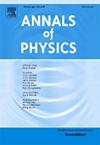Phase-space analysis of an anisotropic universe in f(Q,C) gravity
IF 3
3区 物理与天体物理
Q2 PHYSICS, MULTIDISCIPLINARY
引用次数: 0
Abstract
In this study, we analyze the anisotropic universe in gravity theory. To achieve this, we consider three specific models of gravity and rewrite the equations of motion of each model as an autonomous system. We identify and analyze the critical points, examine their stability, and plot phase portraits to illustrate the behavior of each critical point. The evolution of key parameters, including the equation of state (EoS) parameter , the deceleration parameter , and the standard density parameters and , is thoroughly investigated. The anisotropic dynamical variable exhibits decelerated behavior, consistent with the early universe, while the others demonstrate accelerated behavior, aligned with late-time observations across all models.
f(Q,C)重力下各向异性宇宙的相空间分析
在本研究中,我们分析了f(Q,C)引力理论中的各向异性宇宙。为了实现这一点,我们考虑了三种特定的f(Q,C)重力模型,并将每个模型的运动方程重写为一个自治系统。我们识别和分析临界点,检查它们的稳定性,并绘制阶段肖像来说明每个临界点的行为。深入研究了关键参数的演化,包括状态方程(EoS)参数weff、减速参数q以及标准密度参数Ωm和ΩDE。各向异性动力学变量表现出减速行为,与早期宇宙一致,而其他变量表现出加速行为,与所有模型的后期观测结果一致。
本文章由计算机程序翻译,如有差异,请以英文原文为准。
求助全文
约1分钟内获得全文
求助全文
来源期刊

Annals of Physics
物理-物理:综合
CiteScore
5.30
自引率
3.30%
发文量
211
审稿时长
47 days
期刊介绍:
Annals of Physics presents original work in all areas of basic theoretic physics research. Ideas are developed and fully explored, and thorough treatment is given to first principles and ultimate applications. Annals of Physics emphasizes clarity and intelligibility in the articles it publishes, thus making them as accessible as possible. Readers familiar with recent developments in the field are provided with sufficient detail and background to follow the arguments and understand their significance.
The Editors of the journal cover all fields of theoretical physics. Articles published in the journal are typically longer than 20 pages.
 求助内容:
求助内容: 应助结果提醒方式:
应助结果提醒方式:


